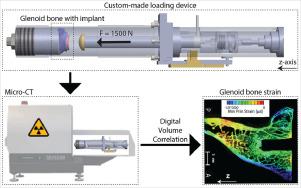Medical Engineering & Physics ( IF 2.2 ) Pub Date : 2020-09-28 , DOI: 10.1016/j.medengphy.2020.09.009 Y Boulanaache 1 , F Becce 2 , A Farron 3 , D P Pioletti 1 , A Terrier 1

|
Glenoid implant loosening remains a major source of failure and concern after anatomical total shoulder arthroplasty (aTSA). It is assumed to be associated with eccentric loading and excessive bone strain, but direct measurement of bone strain after aTSA is not available yet. Therefore, our objective was to develop an in vitro technique for measuring bone strain around a loaded glenoid implant. A custom loading device (1500 N) was designed to fit within a micro-CT scanner, to use digital volume correlation for measuring displacement and calculating strain. Errors were evaluated with three pairs of unloaded scans. The average displacement random error of three pairs of unloaded scans was 6.1 µm. Corresponding systematic and random errors of strain components were less than 806.0 µε and 2039.9 µε, respectively. The average strain accuracy (MAER) and precision (SDER) were 694.3 µε and 440.3 µε, respectively. The loaded minimum principal strain (8738.9 µε) was 12.6 times higher than the MAER (694.3 µε) on average, and was above the MAER for most of the glenoid bone volume (98.1%). Therefore, this technique proves to be accurate and precise enough to eventually compare glenoid implant designs, fixation techniques, or to validate numerical models of specimens under similar loading.
中文翻译:

解剖全肩关节置换术后的关节盂骨应变:微 CT 和数字体积相关性的体外测量
关节盂假体松动仍然是解剖性全肩关节置换术 (aTSA) 后失败和关注的主要问题。假设它与偏心负荷和过度的骨应变有关,但在 aTSA 后直接测量骨应变尚不可用。因此,我们的目标是开发一种体外技术,用于测量负载关节盂植入物周围的骨应变。定制加载装置 (1500 N) 设计用于安装在微型 CT 扫描仪中,以使用数字体积相关性来测量位移和计算应变。使用三对卸载扫描评估错误。三对空载扫描的平均位移随机误差为 6.1 µm。相应的应变分量的系统误差和随机误差分别小于 806.0 µε 和 2039.9 µε。平均应变精度 (MAER) 和精度 (SDER) 分别为 694.3 µε 和 440.3 µε。加载的最小主应变 (8738.9 µε) 平均比 MAER (694.3 µε) 高 12.6 倍,并且对于大部分关节盂骨量 (98.1%) 而言都高于 MAER。因此,该技术被证明足够准确和精确,最终可以比较关节盂植入物的设计、固定技术,或验证类似载荷下标本的数值模型。



























 京公网安备 11010802027423号
京公网安备 11010802027423号